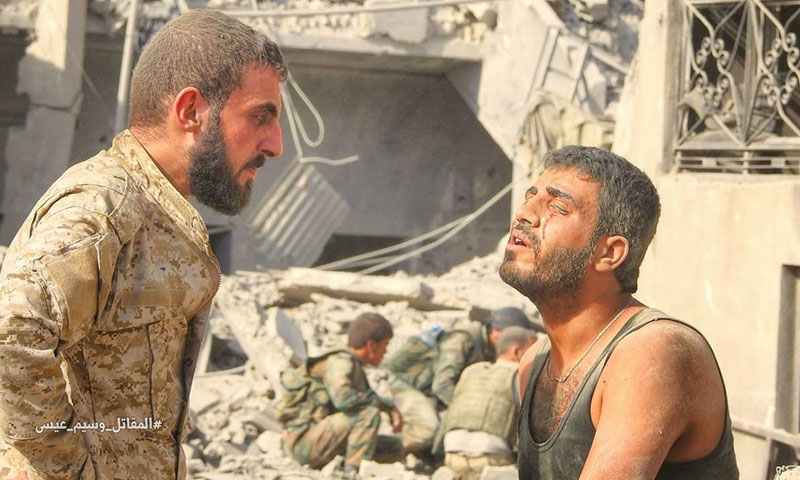The battle of the Vehicles Administration started the second week of its lifespan in the city of Harasta in eastern Damascus, without an accountable progress for Assad’s forces, who failed to break the siege imposed by the opposition factions since 30 December despite the massive enhancements of brigades and militias that positioned themselves in the outskirts of the city of Harasta seeking to achieve progress on the ground.
The opposition factions have succeeded in securing their points in the neighbourhoods of al-Agami, al-Besher Hospital and the Harasta- Arbin road, as well as the residential blocks it managed to control, 350 blocks, to indulge in a street and buildings war, similar to the wars in the Damascene neighbourhood of Jubar, which Assad’s forces failed to control or enter throughout the past years.
The Administration incubates three main departments: The Administrative Department, which contains the Main Command Post and other administrative buildings; the second part includes the Military Maintenance Workshop 446, between Harasta and Arbin, occupying the largest area in the Administration and responsible for the maintenance of all types of military vehicles.
After the Syrian opposition military factions gained control over eastern Ghouta, the Administration turned into an operations center and a center for supplies for the Assad forces’ operations inside Ghouta; it is also considered the first center that is targeting the area with mortars and missiles.
More than 150 Casualties in a Single Week
In the seven days of the “Administration” battle, the Syrian regime mostly lost soldiers. According to Enab Baladi’s observations, in 24 hours, three Brigadier-Generals have been killed: Brigadier General Habib Mehrez Younis from the city of Qardaha, Brigadier General Ibrahim Younis from rural Homs, and Brigadier General Ali Diob, commander of “138 Tanks” Brigade. In addition to 50 soldiers, most of them were “Lieutenants” and “Honorary Lieutenants”, who loyalist Facebook pages have mourned in names throughout the past a few days.
As a confirmation, the “Voice of the Capital Network” quoted a source close to the Syrian regime that the total of casualties among Assad’s forces and ally militias have reached 178 people, until Friday the 5th of January, including 27 disappeared people and others who turned into pieces after “Tahrir al-Sham” have targeted the regime’s assemblies by two bomb cars, one at the beginning of the incursion and the second at the surrounding of al-Mohafaza building.
The opposition factions also had their share of casualties, about 70 members including two leaders in “Tahrir al-Sham” and a number of fighters under the “al-Rahman Legion.”
The pro-regime media showed prisoners, whom Assad’s forces have arrested during their progress to a certain point, while the two parties, the opposition and the regime, have exchanged videos of casualties and prisoners of both sides.
As for the people besieged within the Administration, there are about 350 elements, whom Assad’s forces have been trying to release through a network of tunnels and military enhancements brought from the outskirts of the city of Harasta.
According to sources, large areas of the “Administration” are held by the opposition, which besieges the “Maintenance Workshop 446” and the Technical Institute.
The Regime Indulges 8 Military Formations
Despite the military weight and the enhancements brought to the area, Assad’s forces have not yet achieved any progress.
An informed source told Enab Baladi that the troops which the city of Harasta witnessed are “fake ones,” which have no effect on the ground and confirmed the repeated retreat of “Qalamoun Shield Forces” from the battles amidst accusations of surrendering some of the sites they controlled to the opposition factions.
Triggered by this failure, the regime’s air forces intensified their shelling on the cities and villages of Eastern Ghouta at a rate of 30 raids per day, which led to dozens of casualties, dead and wounded, the last of whom was on Saturday 6 January in the city of Hamouriyah.
In addition to air raids, the cities of Ghouta, particularly Harasta and Arbin, are suffering from surface-to-surface and “Golan” missiles, which have been brought by Assad’s forces and installed at the outskirts of Harasta, at the international highway.
Since the revolution shifted to armed action, the Vehicle Administration occupied an important position, and it was a target for the opposition factions. In 2012, December, the “Free Army” attacked the Administration, managed to violate it and controlled the munition storages, as well as five tanks but failed to control it as a whole.
In November 2013, the factions were able to blow up the Administration building, after arriving through tunnels.
In 2015, the factions launched a military operation called “Nusrat al-Zabadani Battle,” during which they controlled buildings in the Technical Institute of the Administration, but intensive air raids prevented them from controlling the Administration itself.
The last process that targeted the Administration of Vehicles took place at the end of January 2017. The opposition has blown up a tunnel near its main gate; during this attack, Major General Bilal Bilal, Air Commodore Raafat Ibrahim and under-officer Issa Mahyoub were killed.

